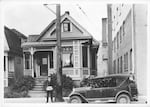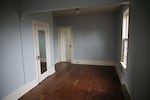Sacramento is a sleepy side street in Northeast Portland’s Eliot neighborhood. But this week, one block was the noisy exception.
Crews were cutting down trees and clearing a path. In a few days, the house in the middle of the trees will be jacked up, put on a trailer and moved.
The home is named after its original owner, an Austrian immigrant named Martin Mayo who built it in 1895. It’s in the Queen Anne style and looks like a gingerbread cottage come to life.
But a fairy tale ending wasn't always assured. Developers own the lot and plan to build 10 new townhouses here. Last year, they notified the city they were planning to tear down the Mayo house, and they got city approval for the razing.
So the city’s planning and historic preservation team started looking for someone who might be willing to take the house if it could be moved.
"I thought, 'I could save the house,'" said Cleo Davis, an artist who lives just a few doors down.
The Mayo house appealed to him because demolition and lost opportunities are a big part of his family’s story — and part of the African-American experience in this part of Portland.

Artist Cleo Davis estimates his family lost $2.5 million in rental income after the city forced the demolition of a small apartment building that belonged to his grandmother in the 1980s.
Amelia Templeton / OPB
“I thought saving this house could bring light to the whole situation,” he said. “And we could have conversations like we’re having right now.”
The conversation he wants to have is about another building, one his family lost.
Back in the 1980s, Davis’ grandmother bought a historic apartment building on this same street from another black family that hadn’t been able to afford the upkeep. The woman known as “Mamma Julia” imagined the apartment would provide for her children and grandchildren.
“The idea was to fix it up, turn it into a rental property,” Cleo Davis said.
The apartment had seven rental units. It also had broken windows and a cracked foundation, and it had been condemned in the city’s so-called fight against blight in Northeast Portland.
Mamma Julia saw it as good investment. Her sons were builders and engineers, and she could pay for the repairs the building needed. But she needed permits from the city. City officials wouldn’t give them to her.
“My grandmother fought it … for two years,” Davis said. “She went to city council, and city council struck it down.”
The apartment was demolished. The Davis family kept the land, lived in a small one bedroom house on the back of the lot. They hung on, barely, as more and more black families were pushed out of the neighborhood.

The Mayo house, built in 1895, has moved twice before, in 1912 and 1930. Many of the city's historic homes were moved to make way for widening streets and new development in the early 1900s.
City of Portland
In a bitter irony, years after the apartment was demolished, it was recognized by the city as a key historic building for Portland’s black community.
“We know that building that came down wasn’t just architecturally significant, but it also told a part of the black story here in Portland,” said Brandon Spencer-Hartle, the city’s historic resources program manager.
And all this brings us back to the Mayo house. The Davis family has offered to let a team of historic preservationists move it to the lot where their apartment once stood. Davis plans to renovate the house — which has already been moved twice as Northeast Portland changed — and open it to the public.
“I plan on opening an archive,” he said. “I’m calling it the ‘art-chive.’”
He envisions a place where historians, artists and members of the black community can preserve and create culture.

The interior of the Mayo House. Davis hopes to transform the building, in its new location, into a place for art and history that celebrates the black community in Portland and the Eliot neighborhood.
Amelia Templeton / OPB
There’s one final twist to this story. For the Davis family, this plan to move the Mayo house meant going back in front of the Portland City Council this week. Among other things, they needed city leaders to waive $40,000 in fees to make the relocation pencil out.
City staff have been pushing hard to make the move work. But before the vote, Davis’s dad, Cleo Davis Senior, told city commissioners that he wasn’t sure if he could trust them. He said his mother was a woman of faith, but he only believes in luck.
“So if you pass this, you know what I’m going do to?” he said. “I’m going to go to my momma’s grave. And I’m going to tell my momma that she was right.”
The council voted unanimously to approve the deal. The historic Mayo house is set to move to its new home January 27.

